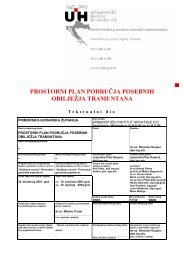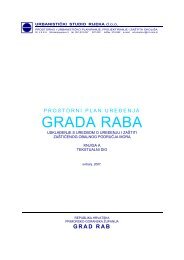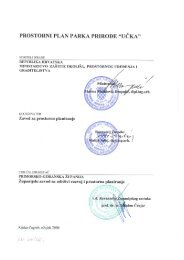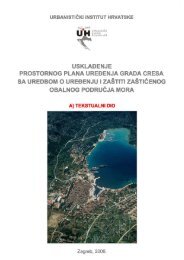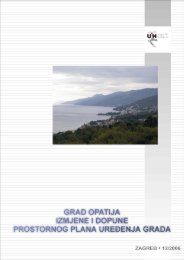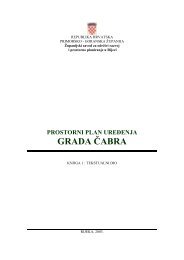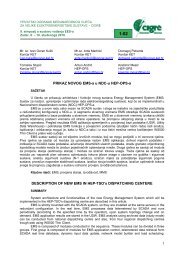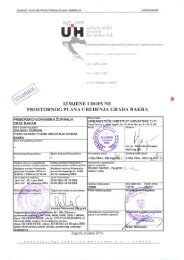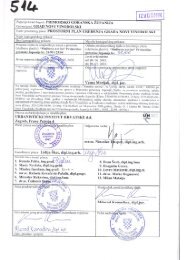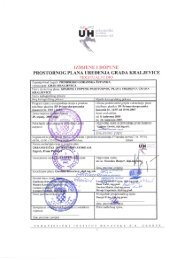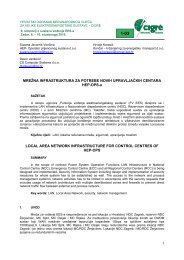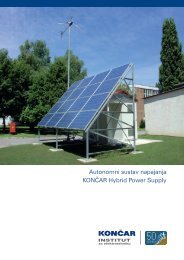Thermo Power Plant Plomin 2 - KONÄAR - Electrical Industry Inc.
Thermo Power Plant Plomin 2 - KONÄAR - Electrical Industry Inc.
Thermo Power Plant Plomin 2 - KONÄAR - Electrical Industry Inc.
Create successful ePaper yourself
Turn your PDF publications into a flip-book with our unique Google optimized e-Paper software.
<strong>Thermo</strong> <strong>Power</strong> <strong>Plant</strong> <strong>Plomin</strong> 2<br />
nature :: energy :: končar
THERMAL POWER PLANT PLOMIN 2<br />
CROATIA<br />
ISTRIA<br />
The thermal <strong>Power</strong> <strong>Plant</strong> <strong>Plomin</strong>, Unit 2 (TPP2), with<br />
210 MW output, is located on the eastern coast of the<br />
Peninsula of Istria at the very end of <strong>Plomin</strong> Bay.<br />
The main buildings, the boiler room and the powerhouse,<br />
are built next to Unit 1. All the other facilities with the<br />
exception of the sea cooling water pumping station, the<br />
quay and the ashes depot are placed within the fenced<br />
area of the <strong>Plant</strong>. The quay and the sea cooling water<br />
pumping station are located in <strong>Plomin</strong> Bay, while the ashes<br />
depot is about 1 km away from the <strong>Plant</strong>.<br />
TEP 2 is jointly owned by the Croatian Electricity Utility<br />
(HEP) and Rheinisch-Westfällisches Elektrizitätswerk<br />
Aktiengesellschaft (RWE Energie) - Germany.<br />
FUEL<br />
Hard coal is used as a fuel with a lower heating value from<br />
24 to 29.3 MJ/kg and sulphur contents between 0.3 and<br />
1.4%.<br />
MAIN PARTS OF THE PLANT<br />
The main plant equipment consists of a single-tube oncethrough<br />
steam generator, a condensing steam turbine and<br />
a turbo generator with electrical equipment. In addition,<br />
there is a range of auxiliary systems and equipment<br />
necessary for operating the whole process of power<br />
generation. Some of them serve both Units, such as the<br />
coal supply system, the waste water treatment plant, the<br />
transport system, the slag and ashes depot, the chimney,<br />
the sea cooling water system and the raw water supply<br />
system.
Thermal <strong>Power</strong> <strong>Plant</strong> <strong>Plomin</strong> 2
BASIC TECHNOLOGY PROCESS<br />
Thermal <strong>Power</strong> <strong>Plant</strong> <strong>Plomin</strong> 2
BOILER<br />
The boiler consists of a steam generator and various auxiliary<br />
systems built into the boiler or around it, participating in<br />
the process of steam production. The manufacturer of the<br />
steam generator is the company “Đuro Đaković” from the<br />
town of Slavonski Brod, Croatia, under Sulzer company<br />
licence. Pulverized coal is used as the main fuel. The coal<br />
is transported from the depot by belt conveyors to six coal<br />
bunkers placed between the power house and the boiler.<br />
From the coal bunkers coal is continuously transported to<br />
mills where it is ground and dried. The pulverized coal dust is<br />
introduced into the boiler furnace through the fuel nozzles by<br />
a current of air. Extra light fuel oil is used for the starting and<br />
supplementary firing of the coal fuelling. The specific criteria<br />
for reduction of nitrogen oxides (NOx) have been applied<br />
to the construction of the furnace, thereby keeping the<br />
emission values of NOx significantly below the prescribed<br />
limits. Hot flue gases stream towards the top of the boiler<br />
and deliver heat to the evaporating system, the steam<br />
superheater system, the economizer and the air preheater.<br />
The further process comprises cleansing the flue gases of<br />
incombustible ingredients and ashes in the electrostatic<br />
precipitator and decrease the sulphur dioxide content in<br />
the flue gas desulphurization equipment. The process ends<br />
with the release of flue gases into the atmosphere through a<br />
chimney 340 metres high.<br />
The pressurized water-steam system consists of the<br />
evaporating system with a water-steam separator, the<br />
economizer, the steam superheater and the reheater. In<br />
respect of the circulation principle, the steam generator<br />
is once-through, type Sulzer. The main feature of this<br />
circulation principle is that all feedwater that flows freely<br />
through the feeding head evaporates during one flow in the<br />
spiral evaporator. Feedwater is supplied by three feeding<br />
pumps driven by squirrel cage induction motors, 4100 kW<br />
(two of them are necessary for the rated power, while the<br />
third one is a stand-by). Raw water, supplied from the local<br />
spring “Bubic jama”, is processed in the chemical water<br />
treatment plant into demi-water. The capacity of demi-water<br />
production for TPP 2 is 2x 25 t/h and for TPP1 2x 20 t/h.<br />
The main technical data of the boiler:<br />
live steam generation<br />
670 t/h<br />
live steam pressure<br />
14.8 Mpa<br />
live steam temperature 535°C<br />
coal consumption Hd = 24 MJ/kg<br />
80 t/h<br />
steam generator efficiency 92.9%<br />
STEAM TURBINE<br />
The steam turbine is of the condensing type with two<br />
casings, produced by the Steam Turbine Factory ABB from<br />
the town of Karlovac, Croatia.<br />
One casing comprises high and medium pressure. The low<br />
pressure casing is of the double-flow inlet type with direct<br />
steam exhaust into the condenser. The steam turbine<br />
comprises seven levels of unregulated extraction used for<br />
heating the boiler feedwater and the air heater.<br />
Fresh steam enters the steam turbine through stop and<br />
control valves and expands through a group of high<br />
pressure stages. From the high pressure section of the<br />
steam turbine, steam comes into the reheater. After<br />
additional heating, steam flows through appropriate stop<br />
and control valves and comes into the medium pressure<br />
section of the steam turbine where it expands through a<br />
group of medium pressure stages. After release from the<br />
medium pressure part, steam flows into the low pressure<br />
double circulating casing. The exhaust steam is condensed<br />
in the surface condenser, while the condensate is sent<br />
back to the thermal cycle by condensate pumps.<br />
The condenser is cooled by sea water. The sea coolingwater<br />
pumping station is placed in <strong>Plomin</strong> Bay, some 2.5<br />
km away from the <strong>Plant</strong>. Pumps take water from a depth of<br />
25 m and pump it into an open concrete water duct where<br />
the water flows by gravity to the filter station situated by<br />
the <strong>Plant</strong>. Water flows through closed piping from the filter<br />
station to the <strong>Plant</strong>.<br />
The main technical data:<br />
gross steam turbine power<br />
210 MW<br />
(measured on the generator terminals)<br />
unit auxiliaries<br />
18.8 MW<br />
net thermal efficiency of the unit >37%<br />
condenser pressure<br />
4.6 kPa<br />
sea cooling-water flow<br />
8.4 m3/s<br />
COAL SUPPLY SYSTEM<br />
The coal is brought by a ship of the Panamax type with a<br />
capacity of 60,000 tons into <strong>Plomin</strong> Bay where the quay 210<br />
m long is placed.<br />
Unloading is performed by a closed ship-worm-type<br />
unloader that moves on rails along the quay. From the<br />
vessel unloader coal comes to the rubber quay conveyor<br />
that transports it to the weighing machine and the<br />
magnetic separator. From there to the coal depot, coal is<br />
transported by the so-called “tube” conveyor.<br />
Storing on the depot and taking of coal for further transport<br />
to the boiler bunkers is performed by a combined loader/<br />
unloader that moves on rails along the depot.
Thermal <strong>Power</strong> <strong>Plant</strong> <strong>Plomin</strong> 2
ENVIRONMENT PROTECTION<br />
Appropriate technical solutions have been applied to<br />
protect the environment from the impact of thermal power<br />
plant operation so as to keep that impact within the<br />
limits prescribed by the law and regulations. Within the<br />
coal supply system reloading is performed by a closed<br />
ship-unloader, transport by closed conveyor tracks, and<br />
the storing on the open depot is performed along with a<br />
simultaneous wetting process.<br />
The solid incombustible ingredients from the fuel are taken<br />
care of without ground disposal. Flying ashes separated<br />
within the electrostatic precipitator, slag from the boiler<br />
and gypsum from the flue gas desulphurization plant<br />
are stored in special receptacles from where they are<br />
transported to the nearby cement industry.<br />
Purification of flue gas and waste water is performed by a<br />
special plant built for that purposes.<br />
The monitoring of the plant’s impact on air pollution is<br />
performed by emission measuring systems introduced at<br />
the entrance to the chimney itself as well as immission<br />
measuring systems assembled at 5 measuring stations<br />
at appropriate locations around the plant. The measuring<br />
data are continuously monitored and sent to the common<br />
plant supervision system as well as to other authorities in<br />
charge of or/and interested in air quality monitoring.<br />
Purification of flue gases<br />
Flue gases have to be purified prior to their release into the<br />
atmosphere in accordance with ecological standards. That<br />
is the reason why flue gases go through the electrostatic<br />
precipitator and flue gas desulphurization plant.<br />
Within the electrostatic precipitator flue gases are<br />
cleansed of incombustible ingredients and ashes so that<br />
they have no more than 100 mg/m3 of ashes at the exit.<br />
A by-product of combustion of 1900 tons of coal per day,<br />
including approximately 13% of ashes, makes a total of 245<br />
tons of ashes. 90% of that amount is separated as flying<br />
dust in the electrostatic precipitator with an efficiency of<br />
99.8%, while the remaining 10% is ashes from the boiler<br />
(slag).<br />
Within the desulphurization plant, flue gases are<br />
purified of excessive sulphur dioxide (SO2) content. The<br />
desulphurization process is based on a wet absorption<br />
process that uses ground limestone. The resulting product<br />
is gypsum, which is used in the cement and civil works<br />
engineering industry. The plant is designed in such a way<br />
that it is capable of purifying flue gases from 700 to 3300<br />
mg/Nm3 SO2 (i.e. from 0.3 to 1.4% of S in the coal).<br />
Waste water treatment<br />
Waste water flows into an accumulation basin with<br />
a volume of 1200 m3 prior to treatment. A separate<br />
purification treatment is applied to the water used for the<br />
desalination of the boiler, slag separator and mud pits of<br />
the powerhouse, and another one to the water used for<br />
desulphurization. Part of the purified water is reused in the<br />
power plant, while the rest flows into the sea.
UNIT CONTROL SYSTEM<br />
All manual and automatic actions in the processes of<br />
the plant are controlled and supervised from the central<br />
control room. Local control is reduced to a necessary<br />
minimum and limited exclusively to those elements that<br />
do not require any direct control action during the running<br />
of the Unit. The main unit control system is TELEPERM XP<br />
(Siemens), while for the turbine control TURBOTROL (ABB)<br />
is applied. For the control of the electrical equipment a<br />
system with a PC network and SCADA software, named<br />
PROZA R/F, made by KONČAR, is implemented.<br />
ELECTRICAL EQUIPMENT<br />
<strong>Electrical</strong> equipment includes:<br />
Turbo generator and unit transformer<br />
• turbo generator with auxiliary systems<br />
• excitation system<br />
• metal enclosed generator busbars with<br />
associated equipment<br />
• 13,8/240 kV unit transformer<br />
TPP2 connection to the power grid<br />
• 220 kV switchyard<br />
• 220/110 kV network transformers<br />
• 110 kV switchyard<br />
Auxiliary and general power supply<br />
• 6.3 kV switchgear<br />
• 0.4 kV switchgear<br />
• diesel generating set and emergency power supply<br />
Electric motor drives<br />
Uninterruptible power supply systems<br />
• 24, 48 and 220 V DC switchgears<br />
• 220 V, 50 Hz stabilised voltage<br />
Control, protection and measurement system<br />
A simplified single-line diagram shows the basic<br />
structure and the main components of the electrical<br />
equipment.<br />
<br />
Thermal <strong>Power</strong> <strong>Plant</strong> <strong>Plomin</strong> 2
TURBO GENERATOR AND UNIT TRANSFORMER<br />
Turbo generator with auxiliary systems<br />
The turbo generator is a three-phase hydrogen-cooled<br />
synchronous generator. The stator frame is gas-tight with<br />
regard to the outer atmosphere, designed in accordance<br />
with standards for machines working in an explosive<br />
environment. The stator core consists of insulated<br />
magnetic laminations arranged in segments separated<br />
by ventilating ducts and tightened elastically inside the<br />
stator frame. The stator winding is made as a two-layer<br />
bar diamond winding with two parallel branches. The rotor<br />
body is one massive piece made of high-alloy nickelchromium-molybdenum<br />
steel. The excitation winding is<br />
made of spatially arranged concentric coils connected<br />
into a series in such a way as to form a two-pole electric<br />
magnet.<br />
The stator core and rotor are directly, and the stator<br />
winding indirectly hydrogen-cooled.<br />
The generator is also able to work without hydrogen as an<br />
Excitation system<br />
The rotor winding is fed from the generator terminals<br />
through an excitation transformer and a thyristor converter.<br />
The thyristor converter is made by a three-phase fully<br />
controlled bridge connection. It consists of four forced<br />
air-cooled thyristor bridges connected in parallel. The<br />
automatic voltage regulator regulates the excitation<br />
voltage and thus the generator voltage as well, with the<br />
help of thyristor control devices. If an automatic regulator<br />
fails the stand-by regulator is automatically switched on.<br />
Generator voltage is built up by field flashing from 0.4 kV<br />
station emergency supply.<br />
The de-exciting of the generator under normal stop<br />
conditions is performed by transition of the thyristor<br />
converter to the inverter operation regime. All excitation<br />
equipment, except the excitation transformer, is installed in<br />
a standard cubicle consisting of 5 compartments placed in<br />
a special closed room by the generator.<br />
air-cooled machine up to a load of 80 MVA.<br />
The generator and auxiliary systems are equipped with<br />
process values measuring equipment (temperatures,<br />
pressures, etc.) needed for supervision and protection of<br />
the generator.<br />
The main rated technical data:<br />
power<br />
247 MVA<br />
power factor (cos φ) 0.85<br />
voltage<br />
13800 V±7.5%<br />
current<br />
10334 A<br />
reactive power at cos φ=0<br />
209.9 MVA<br />
speed<br />
3000 rpm<br />
degree of efficiency under rated<br />
98,65%<br />
conditions at 100% of rated power<br />
stator winding insulation class<br />
F<br />
rotor winding insulation class<br />
F<br />
hydrogen pressure<br />
0.4 Mpa<br />
The basic rated technical data:<br />
excitation current<br />
excitation voltage<br />
excitation transformer power<br />
excitation transformer ratio<br />
2720 A<br />
325 V<br />
2250 kVA<br />
13.8/0.52 kV<br />
Auxiliary systems of gas, sealing oil and cooling water are<br />
used for cooling the generator. The role of these systems<br />
is to maintain the cooling media within the limits necessary<br />
for safe and reliable engine operation.<br />
Any appearance of hydrogen in the proximity of the<br />
generator is detected by the hydrogen detection system.
Metal enclosed generator<br />
busbars with associated equipment<br />
The connection between the generator and the unit<br />
transformer, the neutral point and branches for connection<br />
of the equipment to generator voltage (cubicles with<br />
voltage transformers and overvoltage protection, the<br />
excitation transformer and the auxiliary supply transformer)<br />
is performed by metal enclosed busbars. The conductor<br />
and the enclosure are made of electrolytic aluminium of<br />
99.5% purity. The diameter and the wall thickness of the<br />
main line conductors (generator – unit transformer) is<br />
440/14 mm, and the enclosure is 960/5 mm. The branches<br />
are made with the conductor of 120/4 mm and with<br />
enclosure of 640/3 mm.<br />
The enclosure of each phase closes a space under<br />
overpressure of 1.5 kPa. This overpressure is maintained<br />
by a special device preventing the entry of moisture and<br />
dust into it.<br />
Current transformers on generator terminals and the<br />
neutral point, as well as on auxiliary supply transformer<br />
branches, are placed inside the enclosure. Voltage<br />
transformers, overvoltage protection, and the resistor and<br />
the voltage transformer for earthing the neutral point, are<br />
placed in cubicles under the generator terminals.<br />
Unit transformer<br />
The unit transformer is placed outdoors, in front of the<br />
powerhouse. Connection to the switchyard 220 kV is made<br />
by an overhead conductor fixed by means of insulator<br />
strings between the powerhouse wall and a portal in the<br />
switchyard.<br />
Off-load voltage regulation is possible within a range<br />
of ±2.5%.<br />
It is equipped with a fixed fire extinguisher working with<br />
sprayed water under the pressure of CO2.<br />
The basic technical data:<br />
rated power<br />
transformer ratio<br />
connection group<br />
cooling<br />
245 MVA<br />
13.8/240 kV<br />
YNd5<br />
OFAF<br />
The basic rated technical data:<br />
voltage<br />
current<br />
short circuit current<br />
24 kV<br />
12.5 kA<br />
120 kA<br />
Thermal <strong>Power</strong> <strong>Plant</strong> <strong>Plomin</strong> 2
TPP2 CONNECTION TO THE POWER GRID<br />
220 kV Switchyard<br />
220 kV switchyard is an outdoor air insulated switchgear<br />
(AIS). It consists of 12 bays with double busbar system<br />
and a coupling bay. The busbars are tubular, made of<br />
aluminium alloy E-Al-Mg-Si 0.5 F22 with a diameter of<br />
120/100mm, fastened to supporting insulators.<br />
The switchyard is equipped with circuit breakers,<br />
disconnectors, instrument transformers and surge<br />
arresters, as well as line traps and capacitors for high<br />
frequency communication equipment. Three-pole SF6<br />
circuit breakers are of the one chamber per phase type<br />
with a hydraulic operating mechanism and the possibility of<br />
one and three-pole automatic reclosing. The disconnectors<br />
are of two-column rotary type with motor drives. The<br />
current transformers are with four cores, while the<br />
capacitive voltage transformers are with two secondary<br />
windings for connection of measuring and protection<br />
devices.<br />
Measuring, protection and control devices for each<br />
bay are arranged in five relay houses located within the<br />
switchyard.<br />
Within the switchyard there is a common relay house<br />
comprising AC and DC uninterruptible power supply<br />
systems, sub-distribution for supply of 0.4 kV consumers<br />
and a switchyard stand-by control place.<br />
The basic technical data:<br />
maximum voltage<br />
busbars current<br />
feeder current<br />
short circuit current<br />
245 kV<br />
2000 A<br />
1000 A<br />
20 kA<br />
220/110 kV Network transformers<br />
Connection between 220 kV and 110 kV networks is<br />
performed by means of two three-phase regulating<br />
autotransformers.<br />
A house with fixed fire extinguisher working with sprayed<br />
water under the pressure of CO2 and a relay house for<br />
measuring, protection and control equipment are placed by<br />
the side of the transformers.<br />
The basic technical data:<br />
rated power<br />
150 MVA<br />
transformer ratio 220±12 x 1.25% / 115<br />
connection group<br />
YyN0<br />
OLTC ±12 x 1.25 %<br />
cooling<br />
ONAF
110 kV Switchyard<br />
The existing switchyard has been extended by two<br />
transformer bays and one OHL bay. The concept of the<br />
existing switchyard has been retained for the extension<br />
too. The only difference is that SF6 circuit breakers instead<br />
of pneumatic ones are applied.<br />
Thermal <strong>Power</strong> <strong>Plant</strong> <strong>Plomin</strong> 2
6.3 kV Switchgear<br />
AUXILIARY AND GENERAL POWER SUPPLY<br />
Auxiliary and general power supply consumers are divided<br />
according to their rated voltage into high voltage (6.3 kV)<br />
and low voltage (0.4 kV) consumers.<br />
Auxiliary power supply consumers are supplied by a three<br />
winding regulating transformer, 25 MVA, transformer<br />
ratio 13.8/6.3 kV, connected to the generator voltage by<br />
branches on metal enclosed busbars.<br />
General power supply consumers are fed by a double<br />
winding regulating transformer, 25 MVA, transformer ratio<br />
220/6.3 kV, fed from 220 kV switchyard.<br />
Auxiliary and general power supply switchgears 6.3 kV are<br />
metal-clad with withdrawable vacuum circuit breakers.<br />
The auxiliary power supply switchgear has a single busbar<br />
system, 1600 A rated current, and it consists of 2 sections,<br />
each comprising 16 switching units. Each section is supplied<br />
by a separate secondary winding of the auxiliary power<br />
supply transformer. In the event of a failure of supply in one<br />
section, it is automatically switched to the general power<br />
supply with the help of a fast acting automatic changeover<br />
switch and coupler circuit breakers. This switchgear<br />
supplies the HV motors for the drives of pumps, ventilators<br />
and mills, as well as transformers 6.3/0.4 kV for the supply of<br />
the main low voltage auxiliary distribution panels.<br />
The general power supply switchgear has a single busbar<br />
system of rated current 2500 A with the possibility of<br />
sectioning, and it consists of 12 switching units. This<br />
switchgear supplies 6.3 kV coal transportation system and<br />
flue gas desulphurizing equipment, as well as transformers<br />
6.3/0.4 kV for the supply of the main low voltage general<br />
power supply distribution panels. This switchgear is<br />
connected to both sections of the auxiliary power supply<br />
switchgear in such a way that it can be also used for the<br />
supply of auxiliary power supply consumers, e.g. during<br />
starting and after a failure of a unit. Connection of secondary<br />
transformer terminals with the associated switchgear is<br />
performed with the help of segregated busbars (three pole<br />
metal clad conductors) of the rated power of 1600 A for<br />
auxiliary power supply, and 2500 A for general power supply.
0.4 kV Switchgear<br />
The low voltage auxiliary and general power supply<br />
switchgear consists of main distribution panels and subdistribution<br />
panels.<br />
The main auxiliary and general supply distribution panels,<br />
as well as the main lightening supply distribution panel,<br />
placed in the space between bunkers, are supplied<br />
by corresponding 6.3 kV switchgears though dry-type<br />
transformers 6.3/0.4 kV.<br />
The auxiliary power supply has two main distribution<br />
panels. Each of them is supplied from a separate<br />
transformer 1000 kVA connected to separate sections<br />
of the 6.3 kV switchgear. They supply power consumers<br />
either directly or through sub distribution panels.<br />
The main general supply distribution panel is supplied by<br />
the switchgear 6.3 kV with the help of a transformer 1000<br />
kVA, while the main lightening supply distribution panel is<br />
supplied by the transformer 630 kVA.<br />
Auxiliary and general power supply distribution panels,<br />
in the case of a main supply failure, can be automatically<br />
switched over to supply from the stand-by transformer 1000 kVA.<br />
Consumers on the coal depot and beside the electrostatic<br />
precipitator also have separate transformers and power<br />
distribution. The coal transport system and the flue gas<br />
desulhpurizing plant have their own switchgear 6.3/0.4 kV<br />
for supply of high voltage and low voltage consumers.<br />
Sub-distribution panels are used for supply of consumers<br />
grouped by certain technological equipment. They are<br />
supplied by the main distribution panels.<br />
The 220 kV switchyard has its own sub-distribution cubicles<br />
connected to the general and the emergency power supply<br />
placed in a common relay house within the switchyard.<br />
Distribution and sub-distribution panels are made as<br />
switching units with fixed and withdrawable apparatus<br />
groups, depending on their purpose.<br />
Diesel generating set and<br />
emergency power supply<br />
For the purpose of supply of essential consumers in<br />
the case of a failure of electric energy supply, a diesel<br />
generating unit 800 kVA is installed to take over the supply<br />
within a period of a few seconds.<br />
The diesel – generating set supplies the main distribution<br />
panel for emergency consumption from which power is<br />
distributed to essential consumers.<br />
Checking reliability of operation is performed by means of<br />
a testing system of the operation of the diesel generating<br />
set in parallel to the grid.<br />
ELECTRIC MOTOR DRIVES<br />
For the drives of feeding pumps, sea cooling water<br />
pumps, condensing pumps, absorber pumps, coal mills<br />
and ventilators for fresh air, flue gas, hot air for mills and<br />
recirculation of flue gas, high voltage electric motors are<br />
built in with a power range from 160 to 4100 kW, while<br />
smaller drives are equipped with low voltage motors within<br />
a wide range of powers.<br />
Thermal <strong>Power</strong> <strong>Plant</strong> <strong>Plomin</strong> 2
UNINTERRUPTIBLE POWER<br />
SUPPLY SYSTEMS (UPS)<br />
The supply of consumers whose reliable operation is of<br />
special importance is performed from the uninterruptible<br />
power supply switchgear.<br />
Uninterruptibility of the supply of DC consumers is achieved<br />
by a simultaneous supply of consumers and charging of<br />
storage batteries. In the event of a grid failure and when<br />
the rectifiers stop working, batteries continue to supply<br />
connected consumers without any interruption.<br />
Uninterruptibility of supply of AC consumers is based on<br />
power consumption from a storage battery in the event of<br />
a failure of grid voltage. During normal operation, DC/AC<br />
converters are supplied with DC voltage from a rectifier that<br />
simultaneously charges the battery.<br />
In the event of a grid failure and interruption of operation<br />
of the rectifiers, a storage battery continues to supply<br />
converters and other connected consumers with no<br />
interruption.<br />
Each of the described auxiliary power supply sources<br />
consists of 2 completely identical systems, thus ensuring a<br />
high supply redundancy.<br />
24, 48 and 220 V DC voltage<br />
The unit 220 V DC power supply system is used for the<br />
supply of control, protection and signalisation circuits,<br />
the motors of pumps for the oiling of turbo generating<br />
unit bearings, and the motors of the sealing oil pumps for<br />
the generators, as well as for the needs of orientation<br />
lightening. The system consists of thyristor rectifiers,<br />
1500 Ah lead storage batteries and distribution and<br />
subdistribution panels.<br />
The concept of 24 V DC power supply system, intended for<br />
the supply of unit control devices is conceptually identical<br />
to the previous one and it is equipped with lead storage<br />
batteries 1000 Ah.<br />
For the needs of protection, control and telecommunication<br />
within the switchyard 220/110 kV, 220 V DC system with 200<br />
Ah batteries and 48 V DC system with 250 Ah batteries are<br />
installed.<br />
220 V, 50 Hz AC stabilised voltage<br />
The supply of PCs and remote stations with stabilised AC<br />
voltage 220 V, 50 Hz is performed from the uninterruptible<br />
supply system.<br />
For unit consumers 40 kVA converters are installed, while<br />
for the needs of switchyard consumers 3 kVA converters<br />
are used.<br />
CONTROL, PROTECTION<br />
AND MEASURING SYSTEM<br />
Control of the electrical equipment is organised in several<br />
hierarchical levels:<br />
• local manual control<br />
• HV switchyard control from stand-by control place<br />
• centralised control from main control place<br />
• remote control from RCC Pehlin<br />
The lowest control level is local manual control<br />
performed by classic control-signalling elements on the<br />
corresponding control cubicles or boards. Control cubicles<br />
of switchyard bays, as well as measuring and protection<br />
equipment, are placed in relay houses for each bay. The<br />
electrical protection is implemented by static relays, and<br />
measurement with electronic measuring converters of a<br />
high class of accuracy.<br />
For the needs of remote measuring in the HV switchyard,<br />
separate high accuracy class measuring transducers<br />
are built in as well as two-direction two-tariff active and<br />
reactive energy meters.<br />
Relay protection of the generator, unit transformers and<br />
auxiliary and general supply transformers as well as relay<br />
protection of HV electric motors is built into the separate<br />
cubicles within the relay area behind the unit control room.<br />
The stand-by control place is located in the common<br />
relay house together with the switchyard communication<br />
equipment.<br />
From the main control place in the control room, the<br />
centralised control and monitoring of all electrical<br />
equipment in TPP <strong>Plomin</strong> 2 is performed. This system is<br />
separate and independent of the control system of the<br />
technological part of the unit (boiler, turbine etc.)<br />
The scope and the method of control of the switchyard<br />
from the main and the stand-by control places is identical<br />
because it is performed by a PC network with the same<br />
SCADA software of the type PROZA R/F, produced by<br />
KONČAR KET. The network is of the type Ethernet, with a<br />
speed of 100MBs, realized with optical cables.<br />
The control of electric power equipment in the flue gas<br />
desulphurizing system as well as in the waste water<br />
treatment plant and coal transport and supply systems is<br />
performed from the main control place, and with the same<br />
PC system.<br />
The main and the stand-by control places are equipped<br />
with industrial computers and connected with controlled<br />
plants by a range of remote terminal units.<br />
The communication protocol in accordance with the<br />
IEC 60870-5-101 and optical cables are implemented for<br />
this connection.
The switchgear can also be controlled and supervised<br />
remotely from RCC Pehlin. This control is enabled by a<br />
communication link between computers in Pehlin and<br />
the PC communication sub-system in the common relay<br />
house. In this way remote control does not depend on the<br />
condition and correctness of the PCs in TPP <strong>Plomin</strong>2.<br />
The process information system described is connected<br />
with the TPP <strong>Plomin</strong> 2 business information system,<br />
permitting the transmission of archive files for analyses<br />
and permanent archiving.<br />
The main control place in the control room comprises<br />
three PCs. Two of them are equipped with high resolution<br />
monitors with dimensions of 21 inches placed on the<br />
control board, while the third uses a large 60-inch<br />
projector, instead of a monitor, built-in on the wall in front<br />
of the board. The operator performs the control activities<br />
employing displays of technological schemes and singleline<br />
diagrams and the mouse. By calling up the list of<br />
events, the list of chronology and the different reports and<br />
trend curves of measurements introduced into the system,<br />
the operator has the possibility of detailed insight into<br />
all current data from the processes as well as into their<br />
history within the determined period of time.<br />
Thermal <strong>Power</strong> <strong>Plant</strong> <strong>Plomin</strong> 2
KONČAR IN THERMAL POWER PLANT PLOMIN 2<br />
Končar participated in the construction of TPP 2 from the<br />
design stage to testing and commissioning throughout the<br />
warranty period of the plant.<br />
All activities connected with the electrical equipment were<br />
completed by KONČAR POWER PLANT AND ELECTRIC<br />
TRACTION ENGINEERING (KET) on a «turn-key» basis in<br />
the year 2002.<br />
The following main built-in equipment is manufactured by<br />
factories belonging to the Končar Group:<br />
• Generator<br />
• <strong>Power</strong>, distribution and special transformers<br />
• Instrument transformers,<br />
• Metal enclosed generator busbars<br />
• High, medium and low voltage switchgear<br />
• All voltage levels switching apparatuses<br />
• High and low voltage electric motors<br />
• Rectifiers<br />
• Instrument and protection devices<br />
• Control software etc<br />
Besides the above-mentioned, KET performed together with<br />
subcontractors the erection, testing and commissioning of<br />
the following plants and systems:<br />
inside and outside lighting, communication systems<br />
(interphones, internal telephone lines, radio lines), fire<br />
alarm and fire protection systems, earthing and lightning<br />
systems and anticorrosion protection.<br />
Upon completion of the power plant, its owner, user and<br />
investor Croatian Electricity Utility (HEP) & Rheinisch-<br />
Westfällisches Elektrizitätswerk Aktiengesellschaft (RWE<br />
Energie) entrusted to KONČAR POWER PLANT AND<br />
ELECTRIC TRACTION ENGINEERING (KET), based on annual<br />
maintenance contracts, the preventive and corrective<br />
maintenance of electrical equipment and facilities that KET<br />
has supplied and installed in TEP 2.
SOME OF THE MOST SIGNIFICANT REFERENCES (THERMAL POWER PLANT)<br />
Country<br />
<strong>Power</strong> plant<br />
Number and power of generators<br />
Number<br />
<strong>Power</strong> (MVA)<br />
Cooling<br />
medium<br />
Contract<br />
time<br />
INDIA KAMPUR 1 40 AIR 1965<br />
GERMANY NIEDERRAD 1 80 AIR 1973<br />
S&CG NOVI SAD 1 194 H2 1981<br />
B&H GACKO 1 353 H2/H2O 1981<br />
B&H UGLJEVIK 1 353 H2/H2O 1983<br />
S&CG ZRENJANIN 1 150 H2 1986<br />
S&CG DRMNO 2 410 H2/H2O 1989<br />
CROATIA ZAGREB 2 1 80 AIR 2001<br />
CROATIA PLOMIN 2 1 247 H2 2002<br />
Thermal <strong>Power</strong> <strong>Plant</strong> <strong>Plomin</strong> 2
KONČAR - POWER PLANT AND ELECTRIC TRACTION ENGINEERING <strong>Inc</strong>.<br />
Fallerovo šetalište 22<br />
10000 Zagreb<br />
Croatia<br />
tel +385 1 3667 512, 3667 513<br />
fax +385 1 3667 515<br />
e-mail: info@koncar-ket.hr<br />
www.koncar-ket.hr<br />
Publisher: Končar - <strong>Power</strong> <strong>Plant</strong> and Electric Traction Engineering <strong>Inc</strong>.<br />
Design and prepress: (re)design, Zagreb<br />
Photo: Končar documentation<br />
Press: Stega Tisak, Zagreb, May, 2006.<br />
8300-95-04-0002, rev.2



